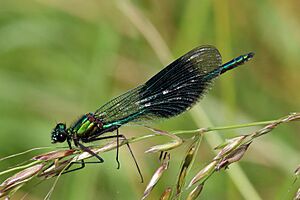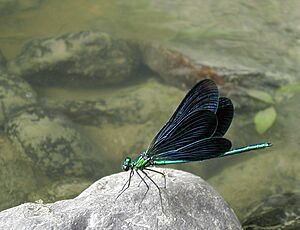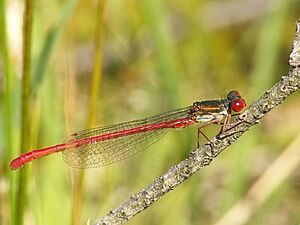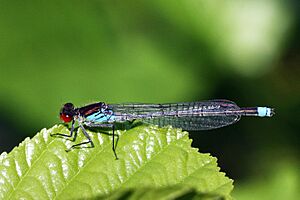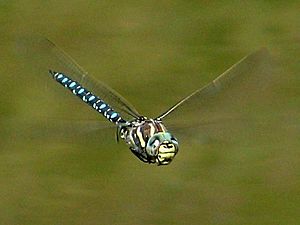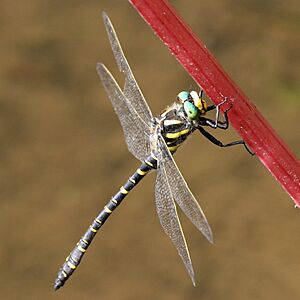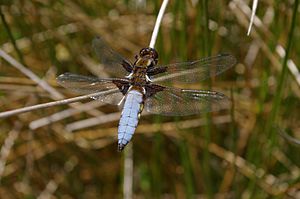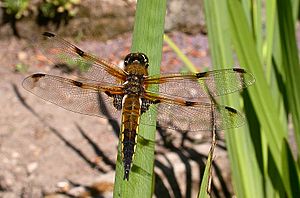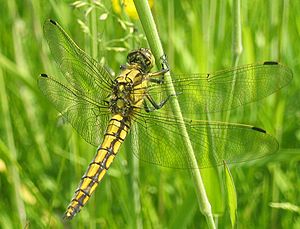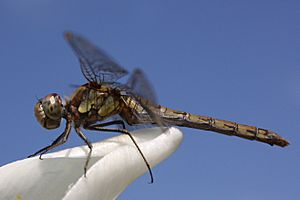List of Odonata species of Great Britain facts for kids
There are 57 different kinds of amazing flying insects called Odonata found in Britain. This group includes two main types: 21 kinds of damselflies and 36 kinds of dragonflies.
Out of these, 42 species (17 damselflies and 25 dragonflies) live and breed in Britain all the time. The others are either species that used to live here but are now extinct, or they are vagrants. Vagrants are visitors that usually live somewhere else but sometimes fly to Britain. This list follows what the Odonata Records Committee has decided about these visitors.
Some of these rare visitors haven't been seen since the 1800s! However, new Odonata species are being discovered in Britain all the time. Some of these new species even start to breed here.
Ireland has a different set of Odonata species compared to Britain. It has fewer breeding species, but it does have one special species not found in Britain: the Irish Damselfly (Coenagrion lunulatum). You can find more information about them on the List of Odonata species of Ireland page.
Contents
New Dragonflies and Damselflies Since 1990
For a while, the list of Odonata in Britain didn't change much. But since 1990, many new species have been found. Some of these have even become regular breeding species. Here are some of the new species, listed by when they were first seen:
- Scarlet dragonfly – This bright red dragonfly was first seen in Hayle Kimbro Pool, The Lizard, Cornwall on August 7, 1995. A few more have been seen in other places across Britain.
- Banded darter (Sympetrum pedemontanum) – This darter has only been recorded once, near Tredegar, Monmouthshire on August 16, 1995. Another darter with dark bands on its wings was seen in Hickling Broad, Norfolk in 2003, and it might have been this species.
- Lesser emperor – First recorded in Cinderford, in the Forest of Dean, Gloucestershire on June 13, 1996. Now, it appears every year. Evidence of breeding was found in Cornwall in 1999, and it seems to live permanently at Dungeness, Kent.
- Green darner – This species was first seen in Penlee Battery, Cornwall on September 9, 1998. This was the first time it had ever been recorded in Europe! Several others were seen in South West England that autumn, but none since.
- Small red-eyed damselfly – First recorded in Essex on July 17, 1999. This damselfly is now a well-established breeding species across much of southern England.
- Southern emerald damselfly – First seen at Winterton Dunes, Norfolk on July 30, 2002. It was seen again in 2003 and 2004 in Norfolk and Sandwich Bay, Kent. However, it hasn't been seen at either place since.
- Common winter damselfly – First recorded in Tonna, Neath in South Wales in December 2008.
- Yellow-spotted emerald – The first and only record of this dragonfly was at Carlton Marshes, Suffolk, in July 2018.
Many people who love Odonata in Britain think that even more new species will be added to the list soon! This list is up to date as of the end of the 2005[update] breeding season.
Extinct and Occasional Breeding Species
Most species on the list are either living and breeding in Britain, or they are rare visitors. But some species don't fit into these groups.
The following species used to breed in Britain but are now extinct here:
- Dainty damselfly – This damselfly was only ever known from marshes along the Thames Estuary in Essex. It was first recorded in 1946 and last seen in 1952. Luckily, it was rediscovered in 2010!
- Norfolk damselfly – This species was only known from the Norfolk Broads between 1902 and 1957.
- Orange-spotted emerald – This dragonfly was only known from two areas in southern England. One was around the River Stour and Moors River in east Dorset, where it was seen from 1820 to 1963. The other was on the River Tamar in Devon, where it was only recorded in 1946.
The following species breed sometimes, but not always:
- Yellow-winged darter – This species sometimes forms small breeding groups after many of them fly into Britain. However, these groups have never stayed permanently.
- Red-veined darter – Like the yellow-winged darter, this species has formed temporary breeding groups after many arrived. But since the mid-1990s, more of these groups have appeared and many have stayed year after year. So, this species is now seen as a successful new colonist.
Non-Native Species in Britain
Non-native Odonata species have only been found in Britain inside warm greenhouses. These greenhouses are usually connected to places that grow water plants. None of these species have been seen living in the wild or starting populations outside.
The British Odonata List
This list shows all the Odonata species found in Britain. They are listed in their scientific taxonomic order. For each species, you'll see its common English name, then its scientific name. For species that breed in Britain, it also shows which countries they live in. There's also a code for species that are not long-established breeding species.
Here are the abbreviations used for where breeding species are found:
- Eng means the species breeds in England.
- Scot means the species breeds in Scotland.
- Wales means the species breeds in Wales.
Here are the codes used to describe species that are not long-established breeders:
- Ex means the species used to breed in Britain but is now extinct here. The year it was last recorded is in brackets.
- RC means the species is a recent colonist (it started breeding after 1990). The year it was first recorded in Britain is in brackets. The Red-veined Darter is an exception, as it has visited and bred occasionally for many decades.
- V means the species has only been recorded as a vagrant (a visitor). The year it was first recorded is in brackets, unless it has a long history of visiting Britain.
Suborder Zygoptera (Damselflies)
Family Calopterygidae (Demoiselles)
| Species | Scientific name | Range countries | Status code |
|---|---|---|---|
| Banded demoiselle | Calopteryx splendens | Eng/Scot/Wales | |
| Beautiful demoiselle | Calopteryx virgo | Eng/Scot/Wales |
Family Lestidae (Emerald Damselflies)
| Species | Scientific name | Range countries | Status code |
|---|---|---|---|
| Willow emerald damselfly | Chalcolestes viridis | V (1899)
RC (2007) |
|
| Scarce emerald damselfly | Lestes dryas | Eng | |
| Emerald damselfly | Lestes sponsa | Eng/Scot/Wales | |
| Southern emerald damselfly | Lestes barbarus | Eng | V (2002) |
| Common winter damselfly | Sympecma fusca | V (2008) |
Family Coenagrionidae (Blue, Blue-tailed, and Red Damselflies)
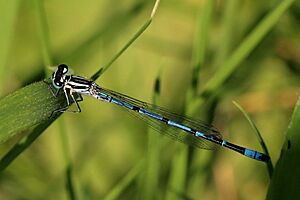

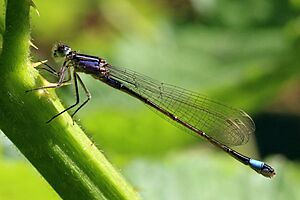
| Species | Scientific name | Range countries | Status code |
|---|---|---|---|
| Small red damselfly | Ceriagrion tenellum | Eng/Wales | |
| Norfolk damselfly | Coenagrion armatum | Ex (1957) | |
| Northern damselfly | Coenagrion hastulatum | Scot | |
| Southern damselfly | Coenagrion mercuriale | Eng/Wales | |
| Azure damselfly | Coenagrion puella | Eng/Scot/Wales | |
| Variable damselfly | Coenagrion pulchellum | Eng/Scot/Wales | |
| Dainty damselfly | Coenagrion scitulum | Eng | RC (2010) |
| Common blue damselfly | Enallagma cyathigerum | Eng/Scot/Wales | |
| Red-eyed damselfly | Erythromma najas | Eng/Wales | |
| Small red-eyed damselfly | Erythromma viridulum | Eng | RC (1999) |
| Blue-tailed damselfly | Ischnura elegans | Eng/Scot/Wales | |
| Scarce blue-tailed damselfly | Ischnura pumilio | Eng/Wales | |
| Large red damselfly | Pyrrhosoma nymphula | Eng/Scot/Wales |
Family Platycnemididae (White-legged Damselflies)
| Species | Scientific name | Range countries | Status code |
|---|---|---|---|
| White-legged damselfly | Platycnemis pennipes | Eng/Wales |
Suborder Anisoptera (Dragonflies)
Family Gomphidae (Club-tailed Dragonflies)
| Species | Scientific name | Range countries | Status Code |
|---|---|---|---|
| Common clubtail | Gomphus vulgatissimus | Eng/Wales | |
| Yellow-legged dragonfly | Gomphus flavipes | V (1818) |
Family Aeshnidae (Hawkers and Emperors)
| Species | Scientific name | Range countries | Status code |
|---|---|---|---|
| Southern hawker | Aeshna cyanea | Eng/Scot/Wales | |
| Brown hawker | Aeshna grandis | Eng/Wales | |
| Norfolk hawker | Aeshna isosceles | Eng | |
| Azure hawker | Aeshna caerulea | Scot | |
| Common hawker | Aeshna juncea | Eng/Scot/Wales | |
| Migrant hawker | Aeshna mixta | Eng/Wales | |
| Southern migrant hawker | Aeshna affinis | V (1952)
?RC (2012) |
|
| Emperor | Anax imperator | Eng/Wales | |
| Lesser emperor | Anax parthenope | Eng | RC (1996) |
| Green darner | Anax junius | V (1998) | |
| Hairy dragonfly | Brachytron pratense | Eng/Scot/Wales | |
| Vagrant emperor | Hemianax ephippiger | V (1903) |
Family Cordulegastridae (Golden-ringed Dragonflies)
| Species | Scientific name | Range countries | Status code |
|---|---|---|---|
| Golden-ringed dragonfly | Cordulegaster boltonii | Eng/Scot/Wales |
Family Corduliidae (Emerald Dragonflies)
| Species | Scientific name | Range countries | Status code | |
|---|---|---|---|---|
| Downy emerald | Cordulia aenea | Eng/Scot/Wales | ||
| Brilliant emerald | Somatochlora metallica | Eng/Scot | ||
| Yellow-spotted emerald | Somatochlora flavomaculata | V (2018) | ||
| Northern emerald | Somatochlora arctica | Scot | ||
| Orange-spotted emerald | Oxygastra curtisii | Ex (1963) |
Family Libellulidae (Chasers, Skimmers, and Darters)
| Species | Scientific name | Range countries | Status code |
|---|---|---|---|
| Broad-bodied chaser | Libellula depressa | Eng/Wales | |
| Scarce chaser | Libellula fulva | Eng | |
| Four-spotted chaser | Libellula quadrimaculata | Eng/Scot/Wales | |
| Black-tailed skimmer | Orthetrum cancellatum | Eng/Wales | |
| Keeled skimmer | Orthetrum coerulescens | Eng/Scot/Wales | |
| Scarlet dragonfly | Crocothemis erythraea | V (1995) | |
| Black darter | Sympetrum danae | Eng/Scot/Wales | |
| Yellow-winged darter | Sympetrum flaveolum | V | |
| Red-veined darter | Sympetrum fonscolombei | Eng | RC |
| Ruddy darter | Sympetrum sanguineum | Eng/Wales | |
| Common darter | Sympetrum striolatum | Eng/Scot/Wales | |
| Highland darter | Sympetrum striolatum nigrescens | Scot | |
| Vagrant darter | Sympetrum vulgatum | V | |
| Banded darter | Sympetrum pedemontanum | V (1995) | |
| White-faced darter | Leucorrhinia dubia | Eng/Scot/Wales | |
| Large white-faced darter | Leucorrhinia pectoralis | V (1859) | |
| Wandering glider | Pantala flavescens | V (1823) |
Other Interesting Odonata Records
Sometimes, Odonata species are reported in Britain, but they aren't always added to the official list. Here are a few examples:
- The Two-spotted dragonfly (Epitheca bimaculata) was reported in Leicestershire in 2002, but it wasn't officially accepted.
- The Blue dasher (Pachydiplax longipennis) was found dead on an oil rig in the North Sea in 1999. Even though its identity was confirmed, it wasn't added to the official British list because this species doesn't usually fly long distances, and the rig gets supplies from Texas. This makes it unlikely it flew there naturally.
- The Southern darter (Sympetrum meridionale) is only known from old specimens with unclear information. However, it has been recorded in the Channel Islands.
- The Alpine emerald (Somatochlora alpestris) is known from just one specimen from 1926. But the person who supposedly collected it was traveling in Europe at that time, so its origin is uncertain.
Scientists have also predicted that some other species might appear in Britain in the future, even though they haven't been seen yet. These include the subarctic darner (Aeshna subarctica), northern white-faced darter (Leucorrhina rubicunda), and small emerald damselfly (Lestes virens).
In addition to the species listed above, the southern skimmer (Orthetrum brunneum) and southern darter (Sympetrum meridionale) have been recorded in the Channel Islands.


